All posts by Children's Staff
About Children's Staff
This post was written by the staff of the Children's Room. Contact Nicole Giroux, Head of Children's for more information. View all posts by Children's Staff →
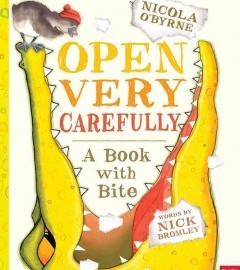
Books for Preschoolers on Wednesday, February 24
We got wild in storytime this morning with books about alligators and crocodiles.
The big wide-mouthed frog swaggers around asking other animals what they like to eat, but when he meets a crocodile, he doesn’t like the crocodile’s answer!

Sing With Your Child!
Sing with your child
any chance you can –

at home, in the car, during a walk, while doing chores.

Bibliobites in January: Life in the Slow Lane
Just a quick reminder that we will meet this coming Friday, February 26, at 11 AM in the Fireplace Room. This month’s assignment was to cook something you’ve never cooked before! I hope you’ve been spending some of our chillier days staying warm in your kitchen, cooking up some challenging recipes. I can’t wait to hear about everyone’s adventures and (possibly) misadventures!
Here is a recap of our January meeting for you to enjoy:
Our longish break over the holidays gave us plenty of time to try out all sorts of recipes from this month’s selection. Author Phyllis Good is a one-woman cottage industry with several titles under the Fix-It and Forget-It banner; and another will be published this year. Her books have sold millions of copies and are well-reviewed by users of every description. So expectations were fairly high, and members approached their task with gusto.
……But we were all somewhat disappointed. The adjective that could best describe most people’s reaction to this book is “lukewarm” (or if you want to get a bit fancy, “tepid”). Some recipes were deemed good, but there were none that drew raves. A few were absolute flops! Though this book is nicely designed, with a clean layout and lots of beautiful photographs, it didn’t win any converts to slow-cooking. Specifically, chicken thighs in a soy sauce marinade were “mealy;” arroz con pollo had overcooked rice; the turkey cutlet was tender but used too much Worcestershire sauce; the broccoli, corn, and onion gratin had undercooked vegetables (when all other components were fully done); the chicken Parm and the ribs were “stewy” and didn’t have the distinct tastes that they should, and the pastitsio was a “gluey mess.” On the other hand, the Asian pork roast “wasn’t bad,” and the mac and cheese was “pretty good.”
A few people tried making breads and/or desserts in their cookers, again with very mixed results. The apple cake was “excellent,” and the cranberry-almond bread was “good but not great.” The quick apple cobbler had a wet texture more like a bread pudding, which would be fine if that’s what you liked and wanted. The yeasted corn bread was a complete failure– it didn’t rise at all and was inedible. It was, however, enjoyed by the raccoons when they discovered it in the compost pile!
There was also some discussion about the cookers themselves. Good tests her recipes exclusively with Rival Crock-Pots, and some thought that these cookers run on the hot side. I recently bought a KitchenAid slow cooker, and it cooks quite a bit more slowly than my old Crock-Pot. Therefore, recipes in this book, particularly the baked items, may suffer if they are made in a slower slow cooker. Also some debated the usefulness of a slow cooker in the first place. Many of Good’s recipes cook in 4 hours or so, so you can’t really fix it and forget it for a full day. And a dish that cooks in 4 hours in a slow cooker can probably be made in an hour or so on top of the stove or in the oven. In thinking about the timing issue after the meeting, I realized I use my slow cooker more for time-shifting rather than all day cooking (it’s like the DVR of cooking!). If you are often out in the hours preceding dinner (carpooling, going to a class, working a later shift), it’s convenient to prep and start dinner in the early afternoon. Then when you arrive home at 6 PM or later, dinner’s ready. Sometimes you do need a recipe that cooks all day, but sometimes it’s more a question of when you’re out rather than how long. Obviously there are as many other ways around this problem as there are cooks, but a slow cooker can be a useful solution for many.
So, we were unimpressed with this title. What, then, is a better one? Here are two of my current favorites:
Not Your Mother’s…. is an older title but is a good basic book. No pictures, though! Slow Cooker Revolution is newer and, in typical America’s Test Kitchen fashion, contains exhaustive information along with reliable recipes. Readers, what’s your pick for a slow-cooker book? We’d love to post your suggestions.
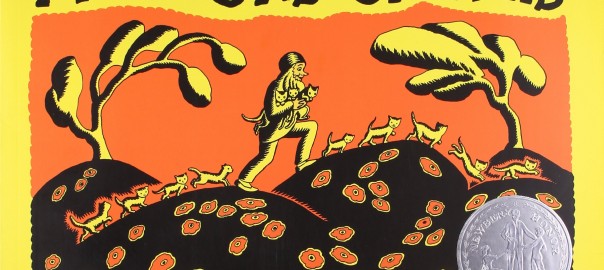
Books for 4-6 year olds on Tuesday, February 23
Today we read a few stories about a certain furry little animal. Our first story was the classic tale of a couple who went looking for a pet and wound up with a bit more than they anticipated….but thankfully it all has a happy ending. This book has a hypnotic refrain that is fun to say with your child:
Then we read a much newer story about a kitten who only wanted a bowl of milk, but had a frustrating time finding it. Does this book have a happy ending as well? Read it to find out!
Last, we read a story about some silly, but busy cats. They needed some help from us in order to make their way through the book. We were glad it wasn’t a CAT-astrophe!
Meow! Meow! What’s your favorite story about kitty-cats?

Toddler book for Monday, February 22
We listened to Goodnight Moon at toddler storytime this morning. Our PlaySpace program will highlight the book this Thursday morning at 10:00. Children ages 2 & 3 are welcome to join us in our great green room. (The meeting room will be transformed to resemble the room in the book, and activities will relate to the story.)
The concept is very simple: show the objects in a room and say goodnight to each one.
“In the great green room
There was a telephone
And a red balloon
And a picture of – ”
At first we see closeups of the room, and the objects in the room, until we get to the page where we begin to say goodnight. Then we see the whole room for the first time. (We see a picture on the wall which is an illustration from The Runaway Bunny – published 5 years earlier.) Next we say, “Goodnight Moon”, even though we hadn’t talked about the moon earlier. The room begins to grow dark. The little bunny looks at the bears in chairs as we say goodnight to them, and he continues looking around. It’s not until we say goodnight to the old lady whispering hush that we see the bunny is all tucked in. You can be all tucked in when you say goodnight to the stars and the air. Finally we say, “Goodnight noises everywhere.” The room is dark. The bunny is asleep in bed. The kittens are asleep on the rocking chair. The old lady is no longer in the room. Only the mouse is still awake looking out at the moon.
To find more toddler books, search the blog by choosing the Books for Toddlers subject heading at the top of this post.
~Maureen
Dads and Donuts Storytime books
The children’s staff has a rotating schedule that includes one or two Saturdays a month. As a result, I do not lead the Dads and Donuts storytime as often as I would like. I love this storytime. It meets once a month on the 2nd Saturday of the month at 10:30 am. Families with young children are invited to join us to listen to some fun stories, learn some songs and rhymes, have coffee and donuts and meet other families.
Today we celebrated 2 holidays: Chinese New Year and Valentine’s Day.
Chinese New Year, or The Spring Festival, began on Monday, Feb. 8. Since it lasts 15 days, we are in the middle of the celebration. I read My First Chinese New Year, because it is a simple overview of the preparations that go into the holiday as well as an explanation of the traditions. It ends with a greeting for the new year. I believe these are the Chinese characters:
恭禧發財
There is a difference in pronunciation between the Mandarin “Gong Xi Fa Cai” and the Cantonese “Gung Hay Fat Choy!” Fewer people use the Cantonese greeting now, but the Cantonese greeting is still in many books published in America. It is in this book, copyright 2004. I’m very curious about this and was told the first wave of immigrants to the United States came from Canton and Hong Kong. Books published in English were Cantonese in origin. I would not be sensitive to this difference if patrons hadn’t pointed it out to me in years past. I certainly welcome all this kind of cultural knowledge!
It is the year of the Monkey, so for the 3rd time this week, I read Monkey and Me by Emily Gravett. Many of the children at this storytime knew this book, so they guessed the animals and had fun acting with me.
I chose a Thomas and Friends story for our Valentine’s Day book. The original Thomas stories were written by Rev. W. Awdry, and there are quite a lot of them. Since being on television, other writers have created stories “Based on The Railway Series”. They seldom have the same quality of the originals, but in this case the vocabulary is easy enough for children to read on their own.
The last book I read was Who Said Red? It is an older book that is no longer in our collection but can be requested from other libraries. It was donated for the book sale, and someone brought it to my attention. (I am usually alerted to books in excellent condition and given the option of adding them to the collection. I’ve decided to keep it in our storytime collection.) Red is a lucky color during Chinese New Year and is associated with Valentine’s Day, so it seemed appropriate to this storytime. I used it in conjunction with the song “Are You Wearing Red Today?”.
~Maureen
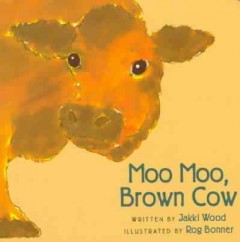
Toddler Storytime, Friday, February 12
We had a great storytime today, held in the Children’s Room. All the grownups participated with great energy, singing along, joining in on the hand movements and really helping to make the storytime a great success for everyone! Thank you.
We read this book today, making lots of animal sounds along the way.

Baby Storytime, 0-12 months, Friday, February 12
A great group of grandparents, fathers, mothers and caregivers gathered together today for Baby Storytime. Each week everyone gets a chance to introduce themselves and their baby. Today there was a lot of talk about helping babies to make the transition to eating solid food. Other caregivers are always a great resource for sharing information and experiences.
We all read together a cute lift the flap book that got the babies interested in seeing what was under each flap. Though we do not have this book in our library, we have many different board books available for you to borrow and read with your little one.

PlaySpace at Home: Sock Matching
This morning’s PlaySpace was a celebration of the classic bedtime story Goodnight Moon.
What we did: One of our activities was a simple sock-matching game that is easy for families to adapt at home. We set out a basket of colorful socks and a clothesline, and encouraged children to compare the colors, patterns, and textures of the socks, match them into pairs, and hang them on the line.
Why it’s important: The ability to compare objects and classify them according to specific traits is a critical early math skill. Recognizing similarities and patterns in everyday things helps children learn to sequence objects and make predictions, which in turn helps them develop logical reasoning abilities. The socks below both have blue stripes, but they’re not exactly the same. When children articulate the ways in which objects are the same and different, they are encouraged to think about alternative ways that those objects can be grouped.


How to do it at home: This one is easy! Ask your child to help you sort socks when you fold laundry. They can match the socks into pairs or sort them into broader categories. Encourage your child to think about different ways the socks can be grouped: by color, texture, or which family member they belong to. Your child can also work on fine motor skills by clipping the socks onto a clothesline.
Taking it to the next level: Once your child has mastered matching objects into pairs and explored various ways of grouping them, you can start to point out more complex patterns in your child’s environment. You can also create your own patterns by stringing colorful beads on a shoelace or building with LEGO. Ask your child to predict the next item in a sequence or identify an object that is out of place.
 Additional reading: For a fun book on this topic, check out A Pair of Socks by Stuart Murphy. It looks at pattern recognition through the story of a lone sock searching for its lost mate, and includes additional activities you can use to further explore these concepts in your child’s everyday life.
Additional reading: For a fun book on this topic, check out A Pair of Socks by Stuart Murphy. It looks at pattern recognition through the story of a lone sock searching for its lost mate, and includes additional activities you can use to further explore these concepts in your child’s everyday life.
~Amy
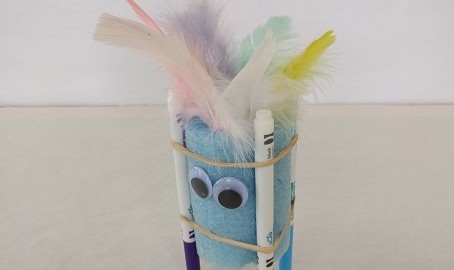
Library Lab: ArtBots!
In our latest Library Lab program, kids in grades 3-5 made robots that draw by themselves. A few people asked for written instructions so they could make these ArtBots at home, so here is the method we used. We got the idea from the Mad Scientists Club at the Cheshire Public Library in Cheshire, CT. Thanks, Mad Scientists! You always do the coolest things.
Supplies:
Electric toothbrushes. We used the GB brand, purchased at our local Dollar Tree store.
Pool noodle. One pool noodle can make about 15 ArtBots.
Scissors
Markers
Pipe cleaners
Rubber bands
Batteries. The toothbrushes we used run on 1 AA battery, which is not included in the package.
Paper
Instructions:
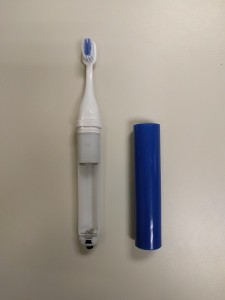
First you need to take apart your toothbrush. Remove the colored cover from the bottom of the brush to reveal the battery casement. You can set the colored cover aside. You won’t need it.
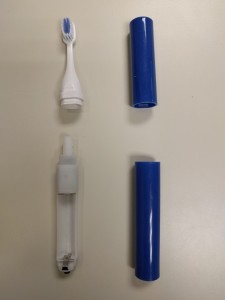 Separate the battery casement and motor from the toothbrush head. You can set the toothbrush head aside as well. In the picture to the right, you can see a toothbrush pulled apart into four pieces. The piece on the lower left is the one you want. This white battery casement and motor unit will provide the power to your ArtBot.
Separate the battery casement and motor from the toothbrush head. You can set the toothbrush head aside as well. In the picture to the right, you can see a toothbrush pulled apart into four pieces. The piece on the lower left is the one you want. This white battery casement and motor unit will provide the power to your ArtBot.
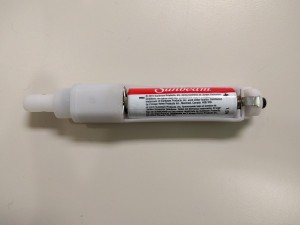 Put a battery in the casement and press the button on the bottom to make sure it works. The whole unit should vibrate when you turn it on.
Put a battery in the casement and press the button on the bottom to make sure it works. The whole unit should vibrate when you turn it on.
Cut off a piece of pool noodle. We used sections that were about four inches long.
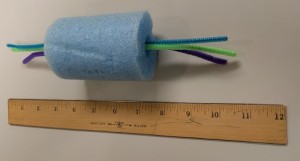 Insert the battery casement and motor into the hole in the middle of your pool noodle. You need to make it as snug as possible. The easiest way we found to do this was to put a few pipe cleaners through the center of the pool noodle before we inserted the toothbrush motor.
Insert the battery casement and motor into the hole in the middle of your pool noodle. You need to make it as snug as possible. The easiest way we found to do this was to put a few pipe cleaners through the center of the pool noodle before we inserted the toothbrush motor.
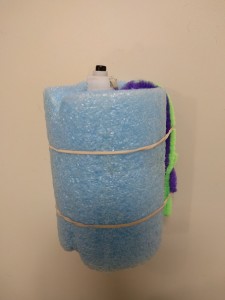 Twist the ends of the pipe cleaner together to secure them on the outside of the pool noodle. Wrap two rubber bands around the outside of the noodle and pipe cleaners.
Twist the ends of the pipe cleaner together to secure them on the outside of the pool noodle. Wrap two rubber bands around the outside of the noodle and pipe cleaners.
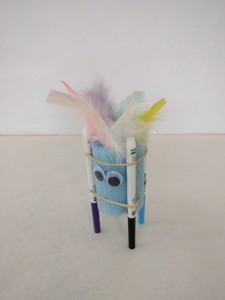 Slide markers under rubber bands. The markers will create the “legs” that your ArtBot walks on. We used four markers for each ArtBot, but you can use as many as you want as long as you have at least three.
Slide markers under rubber bands. The markers will create the “legs” that your ArtBot walks on. We used four markers for each ArtBot, but you can use as many as you want as long as you have at least three.
We decorated our ArtBots with feathers and extra pipe cleaners. This is completely optional, but it was interesting to observe how decorations change the weight and balance of each robot, which in turn affects the way the robots move and draw. Some of the kids in our program attached bells to their robots, so they jingle as they move.
Finally, take the caps off the markers, stand your ArtBot on a piece of paper, press the button, and watch it draw!
ArtBot video!
The kids in our Library Lab program enjoyed experimenting with their ArtBots. What happens if you make one leg shorter or longer than the others? What happens if you use a mix of thin and broadline markers? What happens if you attach a weight to one side of your ArtBot? The possibilities are endless!
//






